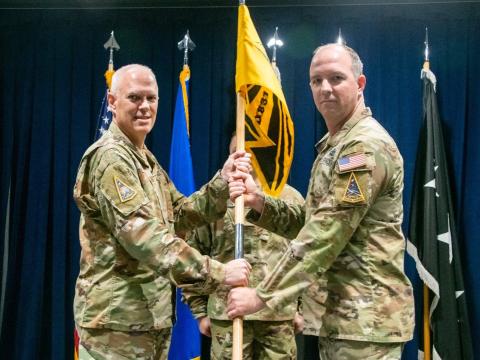New DoD IT Advancement Strategy Aims for Interoperability
Today the Department of Defense (DoD) released its Information Technology (IT) Advancement Strategy named Fulcrum.
“I need everybody's help to turn that vision into reality by changing the decisions that you make every day as you’re solving your own problems in the digital workspace,” Leslie Beavers, DoD principal deputy chief information officer at the senior executive service, emphasized.
Beavers spoke to industry and military officials at AFCEA International’s TechNet Cyber conference and held a media roundtable in Baltimore on June 25.
The policy, approved June 20 by the Deputy Secretary of Defense Kathleen Hicks, emphasizes a user-centric and cross-cutting approach, according to a June 25 release.
“[The strategy] will ensure the Department delivers capabilities aligned with warfighting mission objectives,” the release stated. “This new strategy prioritizes user experience and investment in infrastructure that is both agile and scalable to meet the dynamic requirements of operations and opportunities offered by the most modern technologies.”
Essentially, the DoD chief information officer's office will pursue four lines of effort to provide the necessary IT to connect, protect, perform for and support the nation’s warfighters. A portfolio of strategic objectives will accompany each line of effort and describe the steps DoD will take and provide measurable mechanisms to track progress.
Line of Effort 1 - Provide joint warfighting IT capabilities that are functional, scalable, sustainable and secure in today’s dynamic and contested global environments. Improve available data and information to warfighters to gain decision and competitive advantage in high-tempo, multidomain operations.
Line of Effort 2 - Modernize information networks and compute capabilities to rapidly meet mission and business needs by leveraging best-in-class technologies and a data-centric zero-trust cybersecurity approach. Deliver a secure modernized network that has faster data transfer and lower latency with improved global dynamic resiliency.
Line of Effort 3 - Optimize IT governance to drive efficiencies in capability delivery and enable cost avoidance and savings through streamlined governance and acquisition policies.
Line of Effort 4 - Cultivate a premier digital workforce to ensure readiness to deploy emerging technology that supports the warfighter. Broaden the DoD’s ongoing efforts to identify, recruit, develop and retain the best digital talent the country has to offer. The DoD Cyber Workforce Framework will now also focus on the greater digital workforce with the inclusion of work roles for data, artificial intelligence and software engineering.
Beavers, who began her DoD career as an intelligence officer in the United States Air Force, is no stranger to everyday challenges military personnel face. “When I was a young captain major,” she began, “the big challenge that I wanted to get after for the department was to have us make our IT systems as interoperable as we experience in our personal lives.”
Her 2018 arrival to the Pentagon aimed to bring ease to employee access management, which led to the release of Project Herald.
“As we transitioned, as Honorable Sherman asked me to come and work with him in the Chief Information Office, he wanted to make that pivot across the department as well,” Beavers stated.
John Sherman recently announced his departure from the DoD as he sets on a journey to Texas A&M University to serve as dean of the Bush School of Government. Sherman served as the CIO since December 2021. The department has not yet announced a successor to become the next CIO, who will oversee the Fulcrum efforts.
“We embarked on a journey in January,” Beavers continued. “We pulled together a writing team of about 40 folks and generated what is now called Fulcrum.”
Positioned at the nexus between the most crucial DoD strategies—the National Security Strategy, the Workforce Implementation Strategies, the Software Modernization Strategies and the Cybersecurity Strategies—Fulcrum was designed as guidance to turn strategic visions into operational reality.
“It is the department’s guide to help us as a community get to an interoperable, integrated digital platform, which cannot be done by anyone alone,” Beavers said.
The strategy will be followed by an implementation plan, she added.
Beavers additionally spoke on other ongoing initiatives.
ICAM, or identity, credential and access management, is foundational to the security of joint forces and international partners, Beavers explained.
“ICAM is the root of all evil,” she joked. “That is our big effort this year. We are driving to a truly federated ICAM solution.”
I need everybody's help to turn that vision into reality.
One of her deliverables for the year was to recognize identity attributes for all parties involved, such as the DoD and NATO. “This is a cooperation problem more than a technology problem,” she stated.
“We just need to decide how we’re going to define identity, trust each other, share that information and start moving out.”
The speaker will be leading a group of department members to Tampa, Florida, in July to discuss zero trust and cloud topics and help solve the identity management challenge, she added.
In an ask of industry members, Beavers encouraged the audience not to take cloud transition initiatives lightly. “Please don’t underestimate the level of effort as you’re looking at your organizations to modernize our business systems.”
The newly released Fulcrum strategy will help industry look forward, said Robert Franzen, the deputy customer experience officer at the DoD. Franzen spoke at a media roundtable at TechNet Cyber. “We’re outcome-driven to make things better to the warfighter, so we’re expecting outcomes that improve the user experience.”
Read the DoD's Fulcrum strategy
Kimberly Underwood and Lydia Antonio-Vila contributed to this report.
TechNet Cyber is an annual event held in Baltimore, Maryland, organized by AFCEA International. SIGNAL Media is the official media of AFCEA.




Comments